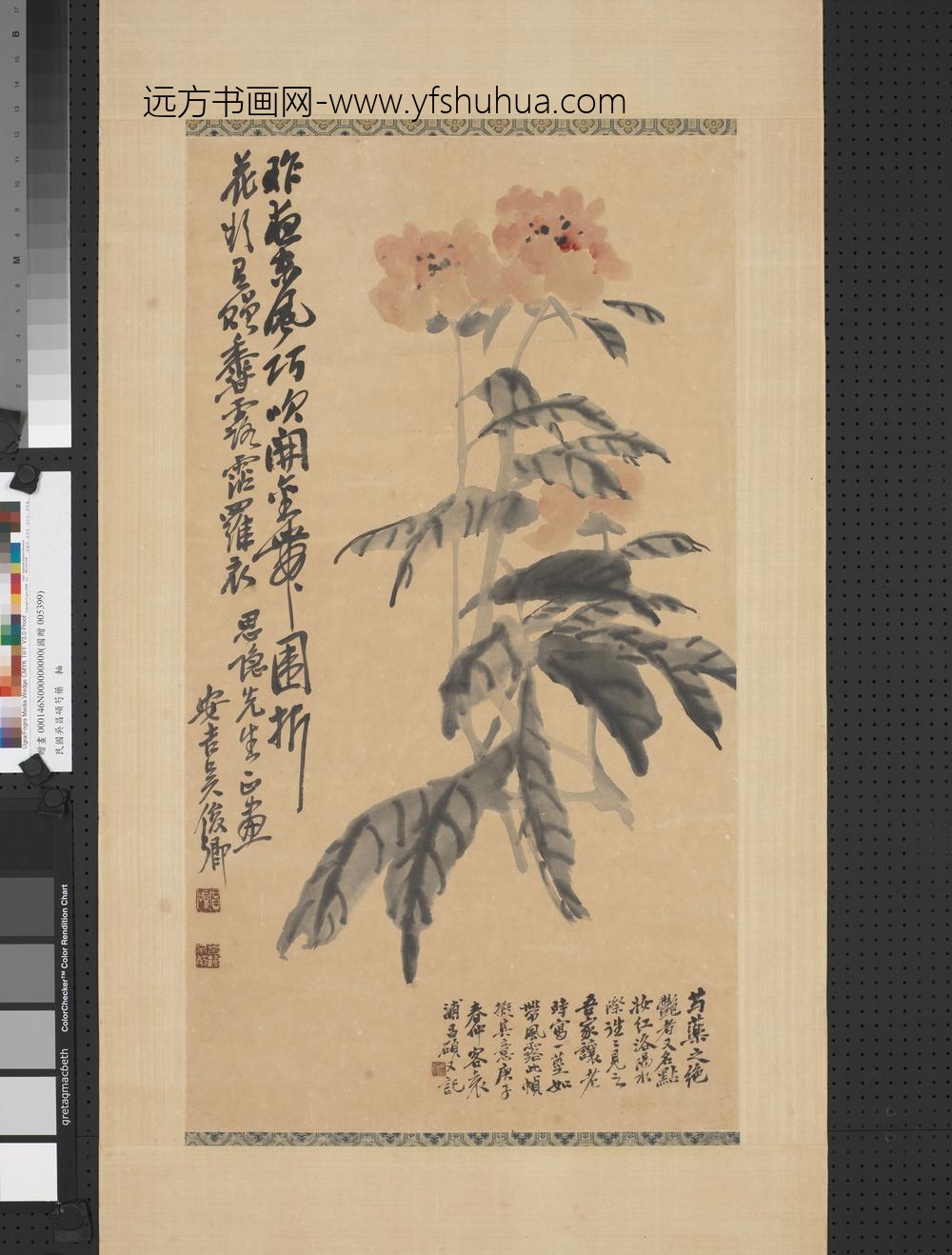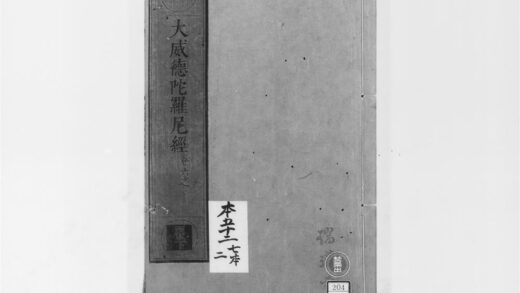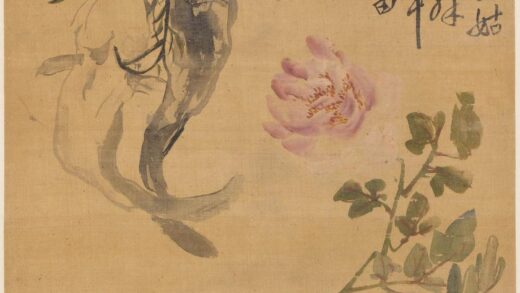【作品基本信息】
| 作者 | 吴昌硕 |
| 品名 | 芍药图轴 |
| 朝代 | 清代 |
| 文件大小 | 18.0MB |
| 分辨率(DPI) | 300×300 |
| 像素大小 | 2134×2813 |
| 尺寸(CM) | 18.06×23.81 |
| 作品数量 | 1 |
| 作品收藏 | 台北故宫博物院 |
| 图片格式 | 默认提供TIF和JPG两个版本 |
基本数据
| 藏品类型 | 绘画 |
| 品名 | 清吴昌硕芍药 轴 Paeonia |
| 分类 | 绘画 |
| 作者 | 吴昌硕 |
| 数量 | 一轴 |
典藏尺寸
| 【位置】 | 【尺寸】(公分) |
| 本幅 | 69.8×38.7 |
| 全幅 | 211×50.8 |
质地
| 【质地位置】 | 【质地】 |
| 本幅 | 纸 |
题跋数据
| 【题跋类别】 | 【作者】 | 【位置】 | 【款识】 | 【书体】 | 【全文】 |
| 作者款识 | 吴昌硕 | 本幅 | 昨夜东风巧。吹开金带围。折花频闲赠。香露沾罗衣。思隐先生正画。安吉吴俊卿。 | 行书 | |
| 印记: 昌硕、苦铁不朽 |
|||||
| 作者款识 | 吴昌硕 | 本幅 | 芍药之绝艳者又名点妆红。洛阳水际往见之。吾家让老时写一茎如带风露。此帧拟其意。庚子(公元一九00年)春仲客袁浦昌硕又记。 | 行书 | |
| 印记: 吴昌石宜寿昌 |
|||||
| 签 | 包首 | 吴昌硕芍药真迹 | |||
印记数据【印记类别】【印记】
主题
| 【主题类别】 | 【主题(第一层)】 | 【主题(第二层)】 | 【主题说明】 |
| 主要主题 | 花草 | 芍药 |
技法
| 【技法】 | 【技法细目】 |
| 写意 |
参考数据
| 【类别】 | 【参考数据】 |
| 内容简介(中文) | 吴昌硕(公元一八四四-一九二七年)名俊,又名俊卿,原字仓石,后改字为昌硕,七十岁后以字行,浙江安吉人。别号缶庐、苦铁、晚号大聋。二十二岁补试秀才,遂绝意进取。钻研诗、书、篆刻。本幅主题为芍药,画家以探古为革新,并以金石书法入画,苍润浑厚,显得古意盎然,生机苍勃。 本幅为朱铭源先生捐赠。 |
| 内容简介(英文) | Wu Ch’ang-shih, a native of Chekiang province, became a civil service candidate at the age of 21 but did not pursue office. Rather, he focused on his studies of poetry, painting, calligraphy, and seal carving. Wu was famous along with Ch’i Pai-shih as “Ch’i of the North and Wu of the South” In the painting here, Wu has depicted peonies. In his paintings, he innovated upon ancient traditions and incorporated calligraphic techniques from ancient bronze and stone inscriptions to create a mature and solemn manner that is at once archaic yet fresh and lively in appearance. This work was donated to the National Palace Museum by Mr. Chu Ming-yuan. |
| 内容简介(中文) | 吴昌硕(公元一八四四-一九二七年),浙江安吉人。原名俊,后名俊卿。字昌硕,又字仓石,别号缶庐、苦铁,又署破荷、老缶、大聋,七十岁后以字行。廿九岁从杨岘习诗文书法篆刻,五十岁始从赵之谦上溯扬州八怪以及石涛、八大、陈淳、徐渭,运以金石书法入画。笔墨坚挺,气魄厚重,色彩浓郁,结构突兀,一笔一画,一枝一叶,无不精神饱满,有金石气。 本幅芍药,红花墨叶,画叶脉如写篆书,笔笔中锋,融书法与绘画为一体,浑然天成。 |
| 内容简介(英文) | Wu Ch’ang-shih, originally known as Chun, and later as Chun-ch’in, was a native of An-chi, Chekiang province. His style names were Ch’ang-shih, Ts’ang-shih; his sobriquets were Tou-lu and K’u-t’ieh, and he also signed his works P’o-he, Laulu, and Ta-lung. After he was seventy he was more commonly known by his style name. When he was twenty-nine, Wu began learning poetry, writing, calligraphy, and seal carving from Yang Hsien (1819-1896). When he was fifty, he began tracing back painting styles from Chao Chih-ch’ien, the Eight Eccentrics of Yangchow, Shih-t’ao, and Pa-ta shan-jen of the Ch’ing dynasty, to Ch’en Ch’un and Hsu Wei of the late Ming. He employed this knowledge of their styles, and utilized his ability to write calligraphy in the style of ancient bronze and stele inscriptions to paint. His brushwork is solid and unyielding, and possesses a dignified spirit. His colors are deep and refined, and his composition is grand, with each stroke, line, and leaf imbued with a vigorous and energetic spirit. A red flower and black leaf are depicted in this painting; each vein of the leaf resembling careful strokes of the ancient seal script. Wu has fused calligraphy and painting skills to present a heavenly combination. |
| 内容简介(中文) | 吴昌硕(1844-1927)名俊,又名俊卿,原字仓石,后改字为昌硕,七十岁后以字行,浙江安吉人。别号缶庐、苦铁、晚号大聋。二十二岁补试秀才,遂绝意进取。钻研诗、书、篆刻。 本幅主题为芍药,画家以探古为革新,并以金石书法入画,苍润浑厚,显得古意盎然,生机苍勃。 本幅为朱铭源先生捐赠于民国69年。(20110204) |
| 内容简介(英文) | Wu Changshi, a native of Anji in Zhejiang province, had the names Jun and Junqing. He later adopted the style name Changshi, by which he was known after the age of seventy. He also had the sobriquets Foulu, Kutie, and later Dalong. At the Chinese age of 22, Wu became a civil service candidate at the level of Cultivated Talent (xiucai) but did not pursue office. Rather, he focused on his studies of poetry, painting, calligraphy, and seal carving. In the painting here Wu has depicted herbaceous peonies. Wu plumbed the depths of antiquity for inspiration, also incorporating calligraphic techniques from ancient bronze and stone inscriptions to create a mature and solemn manner at once archaic yet fresh and lively in appearance. Mr. Chu Ming-yuan donated this work to the National Palace Museum in 1980.(20110204) |
【作品展示】





